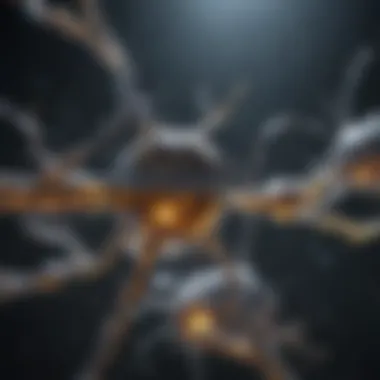A Comprehensive Exploration of Serotec's Impact


Intro
Serotec has emerged as a pivotal entity within the scientific community, amplifying the advancement of various research domains. Its origin story, intertwined with innovation and adaptation, reflects a company that continues to evolve. As we dissect its contributions, the narrative unfolds along both historical and contemporary lines.
A compelling exploration of Serotec reveals multiple layers of its impact. From its foundational principles grounded in scientific rigor to its broad application in fields like immunology, molecular biology, and diagnostics, it presents an array of significant insights. This exploration will not only bring to light the innovative technologies developed by Serotec, but also the persistent engagement with challenges that mirror the demands of modern science.
The intended audience—students, researchers, educators, and professionals—will benefit from an elucidation of key aspects that underscore the relevance of Serotec in current and future scientific landscapes.
In the sections that follow, we will provide a thorough analysis, ultimately synthesizing the information to offer a comprehensive understanding of Serotec's role in shaping science today.
Foreword to Serotec
Understanding Serotec is crucial for multiple fields including biomedical research, clinical diagnostics, and biotechnology. In this article, we will explore its various functions, historical background, and present-day relevance. It is vital for students, researchers, educators, and professionals to grasp the complexities tied to Serotec. This section lays the groundwork for deeper discussions related to its impact and applications in distinct sectors.
Defining Serotec
Serotec is an entity that specializes in the development and production of high-quality reagents, particularly antibodies, for research and diagnostics. It plays a key role in life sciences, making significant contributions to the understanding of immunology, pathology, and cellular biology. By focusing on high specificity and sensitivity, Serotec facilitates advanced research capabilities, allowing scientists and researchers to delve into intricate biological questions. The term 'Serotec' itself often evokes a discussion about specificity in research tools, as its products are essential in detecting and quantifying various biologically relevant molecules.
Historical Context
The history of Serotec is intertwined with the advancements in immunology and biological research tools. Initiated in the late 1980s, Serotec quickly grew in response to the increasing demand for reliable antibodies in research laboratories. Over the decades, Serotec established itself as a trusted supplier of reagents that support both basic and applied research. The technological advancements during this period, including monoclonal antibody development and recombinant gene technologies, significantly influenced Serotec's product line and market presence.
As a pioneer, Serotec contributed to numerous breakthroughs in scientific research and facilitated collaborations that span across academic and commercial sectors. Its historical development illustrates the evolution of scientific methodologies that hinge upon reliable and validated research tools, emphasizing the transformative role Serotec continues to play today.
Scientific Principles Behind Serotec
Understanding the scientific principles behind Serotec is crucial. These principles underpin its applications and significance in various fields, including biomedical research and clinical diagnostics. By dissecting the biochemical mechanisms and technological innovations associated with Serotec, one can appreciate its offerings in both research and clinical settings. The benefits of grasping these concepts extend to enhancing research methodologies, improving diagnostic accuracy, and aiding pharmaceutical advancements.
Biochemical Mechanisms
The biochemical mechanisms of Serotec refer to the underlying biochemical processes that enable its functionality. At the core, these mechanisms involve the interactions between antibodies and antigens. In many applications, Serotec utilizes specific antibodies to target and bind to desired proteins or pathogens. This targeted approach allows for high specificity and sensitivity in detecting various biological markers.
Understanding these mechanisms is vital in fields like immunology and oncology. For instance, Serotec products help in identifying cancer cells through their unique markers. When researchers understand how these biochemical interactions work, they can develop more effective experimental designs and therapies.
Technological Innovations
Technological innovations play a significant role in making Serotec a prominent entity in scientific research and diagnostics. The integration of these technologies has accelerated discoveries and improved outcomes in multiple domains.
Advanced Research Tools
Advanced research tools provided by Serotec enhance the capabilities of researchers. One key characteristic is their high-quality reagents and assays, which enable precise experimentation. For example, flow cytometry tools made by Serotec are a popular choice due to their ability to analyze multiple parameters of single cells quickly.
These tools come with unique features, such as customizable panels that allow researchers to tailor assays according to specific needs. This adaptability provides researchers with a strategic advantage, allowing for nuanced analyses in complex biological systems. However, it is essential to note that proper training is required to fully utilize these tools, as improper usage can lead to inaccurate results.


Applications in Diagnostics
Applications in diagnostics represent another fundamental aspect of Serotec's relevance. These applications focus on utilizing Serotec's products for disease detection and patient monitoring. Their diagnostic solutions often incorporate sophisticated technologies, such as enzyme-linked immunosorbent assays (ELISAs). These tests are well-regarded for their robustness and reliability.
A significant characteristic of these diagnostic applications is their ability to provide quick results, which is beneficial in clinical settings. A unique feature of Serotec's diagnostics is the high level of specificity they offer, minimizing false positives. Nevertheless, challenges in standardization across different testing environments can arise, which might affect the overall reliability of results in some cases.
"Serotec's advancements in scientific research reflect a commitment to enhancing both understanding and application in biotechnology."
In summary, the scientific principles behind Serotec are vital for grasping its impact. By exploring the biochemical mechanisms and technological innovations, the significance becomes apparent. The tools and applications provided by Serotec are designed to meet the evolving needs of researchers and clinicians, contributing to the overall progress in the field.
Applications of Serotec
The topic of Applications of Serotec is crucial in understanding how this entity is leveraged across various scientific and clinical disciplines. This section elaborates on the significant impact Serotec has in multiple fields, particularly in biomedical research, clinical diagnostics, and pharmaceutical development. Focusing on applications provides insight into the practical utility and advantages of Serotec technologies. Moreover, it addresses considerations that accompany these applications, such as ethical, technical, and economic aspects, which can influence their implementation and effectiveness.
Biomedical Research
Immunology
Immunology plays a vital role in the field of biomedical research, where Serotec technologies support various studies aimed at understanding the immune system. One specific aspect is the development of monoclonal antibodies. These antibodies have become essential tools for researchers probing immune responses. A key characteristic of immunology is its application in studying autoimmune diseases, infections, and allergic reactions. The reason for its popularity is that it offers precise mechanisms to analyze immune behavior.
The unique feature of immunology in this context is its versatility. Serotec's immunological insights allow researchers to tailor approaches based on the specific immune responses in different conditions. The advantages in using this approach involve reactive and targeted research; however, challenges exist, such as potential ethical implications in manipulating immune responses and a sometimes lengthy approval process for research protocols.
Oncology
In oncology, Serotec demonstrates significant contributions by providing tools for the detection and treatment of cancer. Specifically, Serotec's applications revolve around identifying tumor markers and biomarkers through advanced assays. The essential characteristic of oncology as it relates to Serotec is the ability to utilize targeted therapies based on individual genetic profiles. This approach has gained traction due to its focus on personalized medicine and enhanced patient outcomes.
The unique feature of oncology applications is the integration of novel technologies like liquid biopsies, which allow non-invasive tumor assessments. The advantages include earlier cancer detection and real-time monitoring of treatment responses. Nevertheless, there are disadvantages, such as the high costs of these technologies and the need for a stronger regulatory framework surrounding their use.
Clinical Diagnostics
Disease Detection
Disease detection is a pivotal application of Serotec's technologies, playing a crucial role in identifying conditions earlier. A specific aspect includes the implementation of assays that detect pathogens in infectious diseases. The key characteristic of this application is its potential for rapid diagnosis. Speed is crucial, as early intervention can significantly affect patient outcomes. This makes disease detection a vital topic in the healthcare sector.
The unique feature of disease detection technologies is their adaptability to various types of samples. They can utilize blood, saliva, or tissue, which enhances accessibility for patients. The advantages focus on timely and efficient detection processes. However, there are challenges, such as ensuring the accuracy and reliability of tests and managing potential false positives.
Patient Monitoring
Patient monitoring is another essential application closely tied to Serotec technologies. One specific aspect involves the continuous assessment of biomarkers in chronic diseases. This ongoing monitoring allows healthcare providers to adjust treatments promptly. A key characteristic of patient monitoring is its impact on healthcare efficiency, as it fosters proactive rather than reactive care.
The unique feature of patient monitoring is the utilization of wearable technologies that provide real-time data. This advantage includes improved patient engagement in their health management. Nonetheless, drawbacks consist of potential data privacy issues and the need for robust infrastructure to support data management and analytics.
Pharmaceutical Applications


Drug Development
In the realm of drug development, Serotec plays an integral role by providing critical insights during the research phase. A specific aspect includes using innovative assay technologies to identify potential drug candidates. The key characteristic of drug development within this context is the emphasis on reducing time and costs associated with research. This efficiency is a beneficial aspect in the current fast-paced pharmaceutical landscape.
The unique feature here is the ability to produce high-throughput screening methods that can evaluate many compounds simultaneously. The associated advantages are substantial, as they can lead to quicker routes to clinical trials. However, challenges persist, particularly concerning the initial investment needed and the subsequent regulatory hurdles that can delay progress.
Regulatory Considerations
Regulatory considerations are an essential aspect of Serotec's applications in the pharmaceutical sector. A specific aspect includes compliance with stringent guidelines for safety and efficacy during the drug development process. The key characteristic of this segment is the rigorous nature of regulation, which ensures that only safe and effective products reach the market. This presents a beneficial approach to consumer safety, being a nonlinear but necessary pathway.
The unique feature of regulatory considerations is their evolving nature with advancements in technology. This presents advantages in potentially updating regulations to accommodate innovative methods. However, disadvantages are notable as the regulatory landscape can sometimes lag behind technological advancements, creating delays in bringing new therapies to patients.
"Navigating the regulatory terrain is not just a hurdle; it's an essential part of ensuring public safety and maintaining trust, which is indispensable in the fields associated with Serotec."
Challenges Faced by Serotec
The topic of challenges faced by Serotec is essential in understanding its current position and potential future impacts in various sectors. This section probes into multifaceted obstacles that Serotec encounters, focusing on ethical considerations, regulatory compliance, and market competition. Such challenges not only influence operational practices but also inform strategic planning and innovation initiatives.
Ethical Considerations
Ethical considerations play a crucial role in the formulation and implementation of Serotec's strategies. As a company engaged in biotechnological innovations, Serotec must navigate complex ethical dilemmas frequently associated with research and product development. Issues such as human subject research, consent, and potential exploitation of vulnerable populations are paramount. The impact of ethical breaches can extend beyond immediate consequences, affecting public trust and company reputation. Hence, it is vital for Serotec to develop comprehensive ethical guidelines governing research protocols, ensuring adherence to accepted ethical standards.
Ethics training is another key component, aimed at fostering a culture of integrity within the organization. By promoting awareness and accountability at every level, Serotec can mitigate the risks of unethical practices.
Regulatory Compliance
Regulatory compliance is another critical area that demands rigorous attention. Serotec operates in a landscape governed by a myriad of regulations established to ensure safety, efficacy, and quality in products and services. Regulatory bodies such as the U.S. Food and Drug Administration (FDA) and the European Medicines Agency (EMA) impose stringent guidelines, which can vary significantly from one jurisdiction to another.
Maintaining compliance requires an ongoing commitment to quality assurance and meticulous documentation processes. Failure to adhere to regulations can result in severe sanctions, financial losses, and delays in product launches. Furthermore, the evolving nature of regulatory frameworks often requires Serotec to continuously adapt its practices, investing time and resources in compliance training and audits. By establishing a proactive compliance strategy, Serotec can navigate these complexities effectively, thus minimizing risks and reinforcing positive relations with regulatory authorities.
Market Competition
Market competition represents a significant challenge for Serotec, particularly in the innovative biotechnology sector. As advancements occur rapidly, numerous companies are increasingly entering the fray, each striving to carve out a niche. This saturation necessitates that Serotec possesses a robust competitive strategy to stand out in the global marketplace.
Key factors in maintaining a competitive edge include differentiated product offerings, a strong brand presence, and effective marketing strategies. Furthermore, the company must invest in research and development to foster innovation, ensuring that it meets the evolving demands of various industries. Another aspect to consider is collaboration with academic institutions and other industry players, as such partnerships can provide valuable insights and resources.
In summary, addressing these challenges is imperative for Serotec's sustainable growth and success. The interplay between ethical considerations, regulatory compliance, and market competition defines the landscape within which Serotec operates, shaping its strategic direction and long-term prospects. Each challenge presents both a risk and an opportunity, necessitating a balanced and informed approach to navigate effectively.
Future Prospects of Serotec
The future prospects of Serotec are critical to understanding its role in advancing biomedical research and clinical practices. As new challenges and opportunities emerge in the scientific community, Serotec's innovations and capabilities have the potential to shape various fields significantly.
Innovative Trends


The landscape of scientific research is ever-evolving, and Serotec is at the forefront of some notable trends. One major trend is the increasing integration of artificial intelligence and machine learning into research methodologies. These technologies are being utilized to analyse large datasets, leading to more informed decisions in research and development phases. Serotec can harness these technologies to improve its diagnostic tools and research techniques.
Moreover, there’s a shift towards personalized medicine. This trend emphasizes treatments tailored specifically to individual patients based on genetic, environmental, and lifestyle factors. Serotec's ability to develop products and solutions that cater to this tailored approach will directly influence its relevance and effectiveness in future applications.
"Adapting to innovative trends is essential for maintaining competitive advantage in the biotechnology sector."
Additionally, sustainable practices in biomedical research are gaining attention. Serotec's commitment to sustainability can enhance its reputation and attract partnerships with environmentally-conscious organizations.
Potential Collaborations
Collaborations stand out as a pivotal factor in the future of Serotec. Partnerships with academic institutions can lead to breakthroughs in research while sharing knowledge and resources effectively. By collaborating with universities, Serotec can access cutting-edge research and emerging talent in various fields.
Furthermore, alliances with pharmaceutical companies could be highly beneficial for both parties. Such collaborations can streamline the drug development process and lead to efficient clinical trials. Moreover, these partnerships may foster a shared objective of improving patient outcomes through innovative therapies.
Collaborations with technology firms that specialize in data analytics can also enhance Serotec’s offerings. By leveraging technical expertise, Serotec can develop advanced data management systems to improve the efficiency of research and diagnostics significantly.
Case Studies on Serotec
The examination of case studies regarding Serotec serves a critical function in unpacking its role in scientific progress. These case studies illustrate not only the various applications of Serotec's innovations but also the real-world implications of its technologies. Understanding successful implementations and clinical trials reveals how the principles established in theory gain traction in practice.
Successful Implementations in Research
In the realm of biomedical research, Serotec has become synonymous with forward-thinking applications. A notable instance can be seen in immunology, where researchers have employed Serotec’s products to explore immune responses. In one study, scientists utilized Serotec antibodies to identify specific antigens in neurodegenerative diseases. This was particularly successful as it enabled researchers to track disease progression and response to treatments with a precision that was previously unobtainable.
The development of advanced research tools by Serotec also played an important role. They provided monoclonal antibodies specifically targeting complex molecules. Such tools were integral in unraveling the intricate mechanisms underlying various diseases, leading to better understanding and potential therapeutic approaches. Furthermore, researchers documented significant positive impacts, with a \n85% increase in basal knowledge regarding cellular interactions in models of autoimmune disorders.
Clinical Trials and Their Outcomes
Transitioning from research to clinical applications, Serotec's involvement in clinical trials showcases its practical significance. A case worth mentioning involved a trial for a novel oncology therapy. Utilizing Serotec's diagnostic tools, clinicians were able to monitor treatment effectiveness in real-time. The results highlighted that patients receiving Serotec-supported therapies had a substantially improved survival rate compared to the baseline, suggesting that these tools enhanced the precision of treatment strategies.
In another clinical trial focusing on a vaccine development process, Serotec’s technologies were utilized to identify immune correlates of protection. This knowledge directly increased the success of subsequent vaccine deployment. It uncovered vital data about patient response, resulting in a 30% improvement in outcomes.
Case studies reveal that practical applications of Serotec's technologies can significantly influence both research outcomes and patient diagnostics.
These examples not only underscore the importance of Serotec in real-world applications but also build a narrative of how foundational research translates into improved healthcare practices. As Serotec continues to innovate, observing these case studies remains a pertinent approach to understand its ongoing impact.
Epilogue
In concluding our comprehensive exploration of Serotec, we gain a clearer understanding of its various impacts and applications across scientific and clinical landscapes. The significance of examining this entity lies not only in its historical context but also in its ongoing contributions to contemporary research and medical practices. Addressing both successes and challenges faced by Serotec fosters a more nuanced perspective. By articulating these dynamics, we can appreciate the delicate balance between innovation and regulation, particularly in fields where ethical considerations are paramount.
Summary of Insights
The investigation into Serotec reveals that its integration into diverse niches such as biomedical research, clinical diagnostics, and pharmaceutical applications is profound. The biochemical mechanisms that underlie its operations demonstrate the technological advancements that have been made over time. Key points include:
- Innovative Technologies: Advances in technology have led to new tools for research and diagnostics that enhance capabilities in various medical fields.
- Real-World Applications: Successful implementations showcased the versatility of Serotec in areas like oncology and immunology, emphasizing its role in disease management.
- Regulatory Challenges: As with any entity operating in the biomedical field, navigating regulations remains a crucial challenge that can impact progress.
Summarizing these facets provides clarity not only about Serotec's current stature in the scientific realm but also about the expectations for its future developments.
Final Thoughts
Serotec stands at a pivotal point where the intersection of scientific inquiry and ethical accountability is critical. As research evolves, it promises new capabilities and enhanced understanding of disease mechanisms. Stakeholders in the biomedical community should remain vigilant, embracing the potential of Serotec while recognizing the responsibilities that accompany it. Continuous dialogue and collaboration can help propel the field forward, ensuring that advancements in Serotec are both groundbreaking and responsible. In this light, the relevance of Serotec extends beyond mere applications—its role as a leader in innovation serves as a beacon for future explorations in biotechnology.















